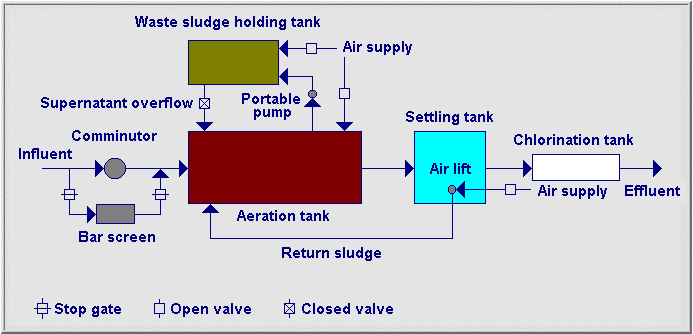Flow - Chart and Explanation of the Extended Aeration - Activated Sludge Process...

Under the normal conditions, wastewater is being linked to the comminutor by closing the stop gates located at the by -
pass line. At the high - flow period or at the emergency conditions, excess flow is being directed to the bar screen via
by - pass channel, by opening the stop gates.
Sludge wasting can be carried out both from the recycling line and the aeration tank directly. Which of them is the best ?
Of course the first one ! Because, you can get a SS concentration varies between 8,000 and 10,000 mg/L at the recycling
line due to thickening property of the settling tank. If you waste the sludge from the aeration tank, you can get a SS
concentration equals to the MLSS value of the aeration tank which varies between 3,000 and 6,000 mg/L depending on the
operational characteristics. The higher SS concentration at the wasted sludge the cheaper sludge dewatering.
 "Sludge Wasting Alternatives"...
"Sludge Wasting Alternatives"...
At the present process, sludge wasting is being carried out from the aeration tank. If it is decided that excess sludge
must be wasted from the system, air valves of the aeration tank and waste sludge holding tank are closed. In addition,
supernatant valve of the waste sludge holding tank is opened. A portable waste sludge pump is located at bottom of the
aeration tank and operated, and wasting procedure is carried out during a certain period of time. Sludge recycling is
being conducted by using a air - lift pump ("Mammoth" pump).
A typical example of a commercially available extended aeration activated - sludge package plant is shown below. In
general, primary clarification is not employed in extended aeration package plants. to avoid the accumulation of solids,
the aeration system should provide sufficient agitation to keep the solids in suspension. To ensure optimum performance
under field conditions, it is recommended that the maximum organic loading, expressed in terms of F : M ratio (food
to microorganism ratio), be in the range from 0.05 to 0.15 kg BOD5/kg MLVSS.day.
 "Design Criteria for Extended Aeration Activated Sludge Process"...
"Design Criteria for Extended Aeration Activated Sludge Process"...
Another critical area of concern is the design of the secondary settling tank and related facilities. It is recommended that
the overflow rate at the design peak hourly flowrate be limited to 24 to 32 m3/m2.day.
Although air lift pumps have been used for returning waste sludge, they are undesirable in this application because the
rate of return cannot be adjusted easily or reliably.
 "Design Criteria for Secondary Settling Tank"...
"Design Criteria for Secondary Settling Tank"...




 "Sludge Wasting Alternatives"...
"Sludge Wasting Alternatives"...
 "Design Criteria for Extended Aeration Activated Sludge Process"...
"Design Criteria for Extended Aeration Activated Sludge Process"...
 "Design Criteria for Secondary Settling Tank"...
"Design Criteria for Secondary Settling Tank"...

